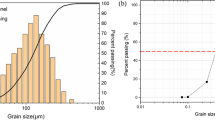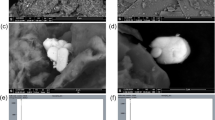Abstract
Water from the Kombat mine was delivered to the Omatako dam via the 263-km-long Grootfontein-Omatako canal during test runs in 1997. It is intended to supply water from Kombat and other underground mines in the Otavi Mountain Land to the capital Windhoek. The Cu-Pb-Zn orebodies are hosted by carbonate rocks and the mine waters are supersaturated with respect to calcite and CO2. Along the length of the canal, the CO2 partial pressure drops from 10−2.1 atm at the inlet of the Kombat mine to 10−3.5 atm at the end of the canal. This is accompanied by a drop in Ca concentration from about 60 to about 20 mg/l. The heavy metal concentrations (Cd, Cu, Mn, Pb and Zn) drop along the course of the canal to values far below the national drinking-water standard. Scavenging by calcium carbonate precipitation is the major depletion mechanism.
Similar content being viewed by others
Author information
Authors and Affiliations
Additional information
Received: 21 June 1999 · Accepted: 29 August 1999
Rights and permissions
About this article
Cite this article
Schwartz, M., Ploethner, D. Removal of heavy metals from mine water by carbonate precipitation in the Grootfontein-Omatako canal, Namibia. Environmental Geology 39, 1117–1126 (2000). https://doi.org/10.1007/s002549900082
Issue Date:
DOI: https://doi.org/10.1007/s002549900082




